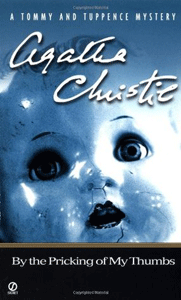Agatha Christie wrote “By the Pricking of My Thumbs” (1968) for the many fans who wrote her letters asking what’s up with Tommy and Tuppence. The husband-and-wife impromptu crime-solvers had last appeared in the World War II-era “N or M?” 27 years prior.
Rather than a cranked-out “thank you” to the fans, “Thumbs” ends up being better than the three previous Tommy and Tuppence books. It reads like a murder-mystery, rather than a sweeping international espionage novel (which the other T&Ts are). It’s technically neither: It’s a crime syndicate novel.
A more traditional mystery
But through clever choices of what to focus on, Christie makes it read like one of her traditional mysteries. Although there’s no core murder to investigate, Tuppence is understandably intrigued by a woman in a nursing home making old-age ramblings that might have a kernel of truth. Mrs. Lancaster implies that a child’s skeleton is bricked up behind a fireplace in a certain country house.

“By the Pricking of My Thumbs” (1968)
Author: Agatha Christie
Genre: Mystery
Series: Tommy & Tuppence No. 4
Setting: England, 1960s
“Thumbs’ ” plot starts slowly, and indeed it moves slowly most of the way – but little to the novel’s detriment. Christie writes the banter between the 60-something married couple as if she writes about them every year – rather than for the first time in decades.
As fans know, T&T are unique among Christie characters because they age in real time (although, admittedly, this novel is probably set earlier in the Sixties than its publication year, based on some references).
We meet them in their 20s, before they are married, in “The Secret Adversary.” By comparison, Poirot is retired and Marple is elderly when we meet them. Both arguably get younger as the years go by – or at least they age very slowly. Christie didn’t plan ahead that she’d be writing about them for decades.
It’s adorable how Tommy and Tuppence are older – and Christie gives nods to this, such as Tuppence’s need for naps — yet they remain youthful in spirit. Tommy remains irked that Tuppence gets herself into dangerous situations pursuing a mystery, yet he has no more power to stop her than he did 40 years earlier.
Wonderful sense of place
As noted, “Thumbs” is slow going: Tuppence drives around the countryside looking for a pink house next to a canal. It’s portrayed in a painting left to the Beresfords by Tommy’s late Aunt Ada. But Tuppence’s frustrating search of the backroads gives “Thumbs” an excellent sense of place.
The house itself is deliciously, almost spookily, mysterious. A couple rents the backside of the house while the canal side is boarded up – however, there is a secret way to get in.
The sense of place is further enhanced when Tuppence meets the friendly locals in the nearby village of Sutton Chancellor. Friendly they may be, but they are reticent to talk about the canal house, who lived there in the past, and who currently owns it.

“Thumbs” might be as repetitively written as some other Christies of this era, but in this case I didn’t mind. I think it’s because the plot moves through its paces at the same rate as Tuppence’s investigations — deliberately, assertively, yet willing to break for afternoon naps.
Something wicked this way comes
A sense of menace permeates it all, confirmed at one point when Tuppence is conked out not by her choice. In other novels, such as “Evil Under the Sun,” Christie aggressively pushes an evil that characters can’t put their finger on. In “Thumbs,” it comes naturally.
The grand finale is believable and appropriately creepy. We have yet another type of murderer – a type previously thought to be off limits as a suspect — to add to the Christie pantheon.
Through it all, even people who are on the fence about Tommy and Tuppence (as I was) will gradually learn to adore them. They are such decent, normal, loving people who happen to have the bug for mystery solving.
Here, Christie reacquires the bug for writing about the couple, as they’d appear one more time in 1973’s much-maligned “Postern of Fate.” Let’s remember them as they are in “By the Pricking of My Thumbs” — older but no less wise, still very much on their games.
Sleuthing Sunday reviews an Agatha Christie book or adaptation. Click here to visit our Agatha Christie Zone.

